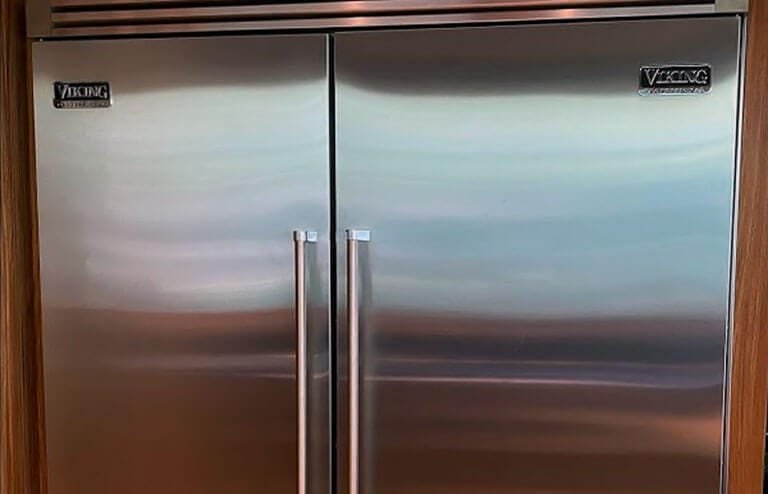Is your Viking refrigerator not cooling? You’re not alone.
Many Viking owners face this issue. A refrigerator failing to cool can be frustrating. It can spoil your food and disrupt your daily routine. Viking refrigerators are known for their reliability, but like any appliance, they can encounter problems. Understanding why your Viking refrigerator isn’t cooling is crucial.
This blog will explore common causes and solutions. Whether it’s a minor fix or a major repair, you’ll find valuable insights here. Let’s dive into the reasons behind a Viking refrigerator not cooling and discover steps to restore its functionality. Keep reading to learn how to keep your fridge running smoothly.
Common Causes
Experiencing issues with your Viking refrigerator not cooling can be frustrating. Understanding the common causes can help you troubleshoot and resolve the problem quickly. Below are some of the most common causes to check.
Power Issues
First, check if the refrigerator is receiving power. Ensure the power cord is securely plugged into the outlet. A loose or disconnected power cord can cause the refrigerator to stop cooling.
Next, inspect the circuit breaker. If the breaker has tripped, reset it and see if the refrigerator starts cooling again. Sometimes, a power surge can trip the breaker and cut off power to the refrigerator.
Thermostat Settings
The thermostat settings are critical for maintaining the correct temperature inside the refrigerator. Check if the thermostat is set to the correct temperature. If it is set too high, the refrigerator may not cool properly.
Consult your refrigerator’s manual to find the optimal thermostat settings. Adjust the thermostat and wait a few hours to see if there is any improvement in cooling. If there is no change, the thermostat itself may be faulty and require replacement.
Viking Refrigerator Not Cooling? [Here is the Basic Troubleshooting]

Experiencing issues with your Viking refrigerator not cooling can be frustrating. Before calling for service, try these basic troubleshooting steps. They might save you time and money.
Check Power Supply
The first step is to check if your refrigerator is getting power. Make sure the power cord is plugged in properly. Inspect the outlet for any signs of damage. Test the outlet with another appliance to ensure it is working.
Also, check the circuit breaker. Sometimes, it might trip, cutting power to the fridge. Reset the breaker if necessary.
Inspect Door Seals
Door seals play a crucial role in maintaining the fridge’s temperature. Check the seals for any cracks or tears. Damaged seals allow warm air to enter, affecting cooling.
To test the seals, close the door on a piece of paper. Try to pull the paper out. If it slides out easily, the seals need to be replaced. Clean the seals regularly to ensure they stay tight.
Advanced Troubleshooting
Is your Viking refrigerator not cooling properly? Advanced troubleshooting may help solve the problem. This section will guide you through some common issues and solutions. Follow these steps to keep your refrigerator in top shape.
Condenser Coil Cleaning
Dirty condenser coils can cause cooling issues. The coils are located at the back or bottom of the refrigerator. Unplug the refrigerator before cleaning. Use a vacuum or brush to remove dust and debris. Clean coils improve efficiency and cooling.
Evaporator Fan Check
The evaporator fan circulates air in the refrigerator. If it stops working, the refrigerator won’t cool properly. Listen for the fan when the door is closed. If you don’t hear it, the fan might be faulty. Check for obstructions or damage to the fan blades. Replace the fan if necessary.
Professional Help
Sometimes, fixing a Viking refrigerator not cooling issue requires more than basic troubleshooting. When the problem seems complex or persists after simple checks, it’s time to seek professional help. A trained technician can diagnose and repair intricate issues, ensuring your refrigerator functions efficiently again.
When To Call A Technician
Consider calling a technician when:
- The refrigerator is still warm despite adjusting the thermostat.
- You hear unusual noises from the compressor.
- There are visible leaks or frost build-up.
- The refrigerator cycles on and off frequently.
- The refrigerator is completely unresponsive.
These signs often indicate more serious issues that require expert attention.
Cost Estimates
Understanding potential costs helps plan for repairs. Here are some common repair costs:
| Service | Estimated Cost |
|---|---|
| Thermostat Replacement | $100 – $250 |
| Compressor Repair | $200 – $450 |
| Condenser Coil Cleaning | $75 – $200 |
| Refrigerant Recharge | $150 – $300 |
| Fan Motor Replacement | $120 – $300 |
These estimates can vary based on the technician’s rates and location. Always request a detailed quote before proceeding with any repairs.
Preventative Maintenance
Keeping your Viking refrigerator in good shape is crucial. Regular maintenance ensures it runs smoothly. It also extends its lifespan. Let’s explore some key preventative steps.
Regular Cleaning
Clean your refrigerator regularly. Start with the shelves and drawers. Remove them and wash with warm, soapy water. Dry them completely before placing them back.
Wipe down the interior walls. Use a mix of water and baking soda. This removes odors and stains. Don’t forget to clean the door seals. This helps maintain a tight seal.
Routine Inspections
Inspect your refrigerator often. Check the temperature settings. Ensure they are at the recommended levels. Look at the condenser coils. Dust and debris can accumulate here. Clean them with a vacuum or brush.
Listen for unusual noises. These could signal a problem. Check for any leaks or moisture. Address these issues promptly. Regular inspections can prevent major breakdowns. They help keep your refrigerator running efficiently.
Diy Fixes
Is your Viking refrigerator not cooling? Don’t worry. You can try some DIY fixes. Addressing common problems might save you time and money. Here are some easy fixes you can do yourself.
Replacing Filters
A clogged filter can affect your refrigerator’s cooling ability. Replacing the filters is a simple task. Follow these steps:
- Locate the filter compartment inside your fridge.
- Remove the old filter by twisting it counterclockwise.
- Insert the new filter and twist it clockwise to secure it.
- Reset the filter indicator light if your model has one.
Make sure to replace the filter every six months. This keeps your fridge running smoothly.
Defrosting The Freezer
Ice build-up can block airflow. This makes your fridge less efficient. Defrosting your freezer is an easy fix. Here’s how:
- Turn off the refrigerator and unplug it.
- Remove all food items from the freezer.
- Place towels around the base to catch melting ice.
- Leave the freezer door open and let the ice melt naturally.
- Wipe down the interior with a clean cloth.
- Plug the refrigerator back in and turn it on.
Regular defrosting can prevent many cooling issues.
These DIY fixes can often solve cooling problems. If the issue persists, you might need professional help. Regular maintenance can keep your Viking refrigerator in top condition.
Energy Efficiency Tips
Keeping your Viking refrigerator running efficiently saves energy and lowers bills. Here are some tips to ensure your refrigerator stays cool without wasting energy.
Optimal Settings
Set the refrigerator temperature between 35°F and 38°F. This range keeps food fresh and prevents excessive energy use. The freezer should be set to 0°F. Avoid setting temperatures lower than necessary. It doesn’t improve cooling but increases energy consumption.
Energy-saving Practices
Keep the refrigerator door closed as much as possible. Each time you open it, warm air enters, causing the fridge to work harder. Organize food items efficiently. This way, you can find what you need quickly. Regularly clean the condenser coils. Dust and dirt build-up can make the refrigerator work harder. Ensure the door seals are tight. Worn-out seals can let cool air escape, causing the fridge to use more energy. Avoid placing hot food directly into the refrigerator. Let it cool to room temperature first. This prevents the fridge from using extra energy to cool the hot food.
User Experiences
Many Viking refrigerator users have shared their experiences online. Some face common issues while others have success stories to tell. Let’s explore these user experiences.
Common Issues
Many users report their Viking refrigerator not cooling properly. This problem can be frustrating. Here are some common issues:
- Blocked Vents: Items blocking the vents can restrict airflow.
- Dirty Coils: Dusty coils can reduce cooling efficiency.
- Faulty Thermostat: A broken thermostat can cause temperature fluctuations.
- Door Seal Problems: Worn-out seals allow cold air to escape.
These issues are common in many user reports. Regular maintenance can prevent most of them.
Success Stories
Despite these issues, many users also share positive experiences. Here are some success stories:
- Professional Repair: Many users found success with professional repair services.
- DIY Fixes: Some users fixed their fridge with simple DIY methods.
- Preventive Maintenance: Regular cleaning and inspections kept issues at bay for some users.
These success stories highlight the importance of proper care. With the right approach, you can keep your Viking refrigerator working perfectly.
Frequently Asked Questions
Why Is My Viking Refrigerator Not Cooling?
Check the thermostat setting. It might be too high. Also, ensure the vents are not blocked.
How Can I Reset My Viking Refrigerator?
Unplug the refrigerator for 10 minutes. Plug it back in. This can reset the system.
What Should I Do If My Viking Fridge Is Still Warm?
Inspect the door seals. They may be loose or damaged. This can cause cooling issues.
How Often Should I Clean My Viking Refrigerator Coils?
Clean the coils every six months. This helps the fridge run efficiently and maintain cooling.
Is A Noisy Viking Refrigerator A Bad Sign?
Yes, it could be. Noise might indicate a problem with the compressor or fan. Check for issues.
Conclusion
Fixing a Viking refrigerator that’s not cooling can be simple. Start by checking the basics like power and settings. Clean the condenser coils regularly. Ensure the door seals tightly. If problems persist, consult a professional. Regular maintenance helps avoid cooling issues.
Keep your Viking refrigerator running smoothly for years. Simple steps can make a big difference. Don’t ignore small issues; they can grow. Take action early for the best results. Enjoy a reliable refrigerator with these easy tips.
